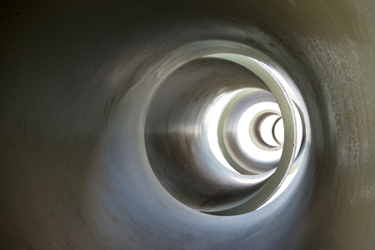Math Solutions Explained: Pipe Volume Gallons

By Daniel Theobald, "Wastewater Dan"

Water Online’s “Math Solutions Explained” series, presented by wastewater consultant and trainer Dan Theobald (“Wastewater Dan”), educates operators by explaining pipe volume gallons calculations.
The volume/capacity in a pipe is calculated as a measurement inside a specific diameter of an exact length. The volume can be expressed in different units; however, this presentation will focus on calculating and expressing pipe volume units in gallons.
Before focusing on details of the calculation, recognizing the advantages of knowing and understanding the calculated pipe volume gallons result are explained here.
To a wastewater operator, the volume/gallons of wastewater impact the contact time or residence time in the entire wastewater treatment plant. Also, it affects the individual wastewater treatment process units.
If the volume of wastewater entering the entire facility or an individual process unit increases, the amount of time to treat wastewater decreases, and if the volume of wastewater decreases, the amount of time to treat wastewater increases.
The volume of incoming wastewater gallons is essential for an operator to respond with control setting adjustments such as adjusting flow rates, changing chemical feed rates, or making other appropriate operational setting adjustments to maintain treatment quality consistency.
Also, to the wastewater operator, the volume of wastewater contains contaminants and contaminant concentrations that impact the quality of wastewater treatment in the entire wastewater treatment plant and affect individual wastewater treatment process units.
If the contaminants and containment concentrations of wastewater entering the entire facility or an individual process unit increase, the amount of time to treat wastewater decreases, and if the volume of wastewater decreases, the amount of time to treat wastewater increases.
The contaminants and containment concentrations of incoming wastewater are essential to an operator to respond with control setting adjustments such as adjusting flow rates, changing chemical feed rates, or making other appropriate operational setting adjustments to maintain treatment quality consistency.
Specific possible actions to consider if the volume of wastewater entering a wastewater treatment facility and or process unit changes are here.
One possible scenario could include a wastewater treatment plant having several process units. The process units could consist of an equalization tank and other process units.
Based on operating the equalization tank with a maximum level of between 50 percent and 75 percent and having incoming wastewater volume increases, a minor flow rate adjustment and a chemical setting change could achieve consistent treatment quality. At the same time, most of the increased volume resides in the equalization tank. Having nominal flow rate and chemical setting changes might not significantly impact consistent wastewater treatment quality.
Similarly, if the volume of wastewater contains changes in contaminants and containment concentrations, the changes identified above might also be appropriate; however, it might be necessary to perform a bench scale analysis of the wastewater to identify appropriate operational setting changes.
Ultimately, knowing in advance when the volume of wastewater entering the wastewater treatment plant will change could be very helpful to the operator, which is where calculating pipe volume gallons is beneficial.
To calculate pipe volume gallons, use the same basic formula to calculate the volume in gallons of a circular tank. For the pipe volume gallons calculation, visualize a circular tank laying on the side, and that can be the visual of a pipe.
The other unique application of calculating pipe volume is to recognize the diameter of a pipe. Typically, the pipe diameter is in inches, and the volume formula uses the dimension as feet. So, it is vital to express the inches of a pipe diameter as a decimal equivalent of feet.
To become more proficient in calculating pipe volume gallons, it is helpful to understand basic wastewater mathematics solution components, such as:
- how to read a math word problem to identify the explicit question;
- learning to select the appropriate formula to solve the exact math problem;
- proficiency in setting up the equation;
- selecting the “known” information and determining what is “unknown” from the word problem
- using units of expression properly while solving the problem
Familiarity with wastewater mathematics can be beneficial in advancing a wastewater operator's career.
Therefore, I have created a Pipe Volume Gallons learning exercise.
I have also created a series of wastewater math learning exercises that will continue to expand with more options.
If you have specific wastewater math queries, please submit areas of interest or a question.
Known in the industry as “Wastewater Dan,” Daniel L. Theobald, proprietor of Environmental Services (www.esdlt.com), is a professional wastewater and safety consultant/trainer. He has more than 33 years of hands-on industry experience since 1987, operating many variants of wastewater treatment processing units, and is eager to share his knowledge about wastewater with others.
Theobald serves as an active consultant for industries looking to achieve, maintain, and improve discharge-permit-compliant wastewater treatment at reduced overall cost. He is a Lifetime Member of the Who’s Who Registry of Professionals and holds numerous certifications from wastewater management regulatory boards and professional organizations. Theobald contributed one chapter to the Water Environment Federation’s (www.wef.org) Manual of Practice # 37 (MOP-37), a technical manual resource guide for biological nutrient removal, published in 2013.
